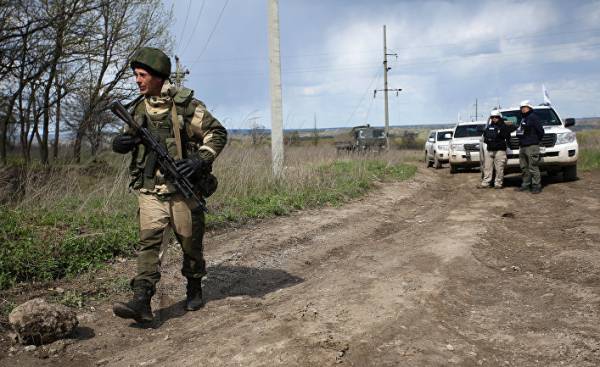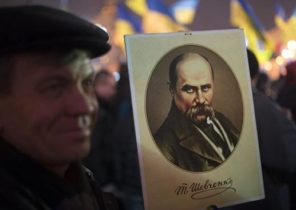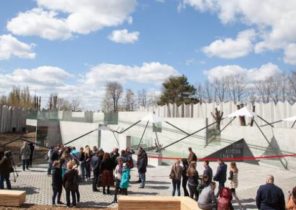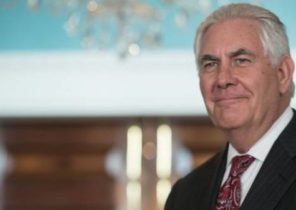
Recently was published the next report of the OSCE observer mission on the situation in the East of Ukraine. In particular, the document says: “Two men with grim faces (…) approached the patrol of the OSCE observers # 2 and began shouting aggressively at the patrol. Then they were gone. When patrol No. 2 was going to go to their second car ran over an armed man and tried to open the door on the driver side and break the glass with a rifle butt. (…) He sent the machine to the driver and front passenger. In response, the patrol had to raise hands up.”
This scene embodies the entire Russian-Ukrainian conflict raging in Eastern Ukraine, on the resolution which the world community. It happened on June 20 at 11:10 hours at the observation post of the OSCE, located 16 kilometres North-West of Donetsk. Shortly thereafter, he heard the screech of tires, the driver of the patrol car pressed the accelerator, an armed man once again kicked butt in the car and slightly damaged it, and then took a round of shots into the air. “I heard three shots, which, according to observers, was aimed in the direction of the car, but didn’t get it”.
Only on Saturday, Russian President Vladimir Putin visited the annexed Crimea Peninsula, prompting a sharp protest of the Ukrainian leadership. How big is the voltage in connection with this conflict, few people know better than Alexander hug. Through the hands of this 44-year-old Swiss pass new reports. The OSCE observation mission was created in March 2014 when the Russian-Ukrainian conflict has just begun. Now here there is a positional war.
“First, we have not yet had an armored car and was supposed to be up to 100 observers,” says hug. “Now we have more than a thousand employees, including 653 international observer “in the fields”. We already have armored vehicles, but we’re still unarmed.” In addition, the disposal of observers have 23 unmanned aircraft and seven stationary cameras, which this year should grow to 23.
A hug, a lawyer by training and a former officer in the Swiss army, is the first Deputy of the mission in the Donbass. He used, in particular, participated in similar operations in the Balkans. Hg is expressed very carefully and accurately: “We are not so naive as to believe that you are able to resolve this conflict. But we contribute to the settlement of objectively reporting on the situation. We are the “eyes and ears” of the global community and take their job very seriously.”
However, in recent months performing this task, formulated in accordance with the decision of the Permanent Council of the OSCE has become much more complicated. In may, according to the BBC, the representative of Russia gave the mission a document, according to which the so-called Donetsk people’s Republic instructs his men to “allow our cars to travel only on pre-approved routes. This is another proof that there are systematic attempts to complicate our execution of our work.”
Obviously, observers are trying to prevent checking for illegal weapons, so they do not appear without warning in different places. “Since the beginning of this year, we found a total of 2500 units of heavy weapons in areas where they weren’t supposed to be shot at a distance from the position of the other side”, that is, from the so-called “contact line” between Ukrainian troops and separatists. It is noteworthy that the plans to prevent the observers openly said the representative of Russia.
Regarding the alleged presence of regular units of the Russian army in the Donbass, the Swiss doesn’t want to speculate. “We have seen armed people in Russian uniform with distinctive signs, and other people who were detained by the soldiers of the Ukrainian army, claimed to be soldiers of the Russian armed forces fighting on the territory of Ukraine,” says hug.
In April, one OSCE observer, a US citizen, was killed when his car allegedly ran over a mine. For the first time cost the life of the OSCE representative, for local residents has long been routine. In the first five months of this year have killed 44 by local residents, and 188 were injured, in particular, from the fragments of grenades.
Both sides of this trench warfare have been responsible for civilian casualties, and both they interfere with the observers to do their job. However, according to hug, the end of April about 80% of the incidents, including several attacks on vehicles of the OSCE, took place in territory controlled by the separatists it. On average once every three days — almost twice as often as before, with the mission happen to serious incidents.
However, representatives of the OSCE can take care of everything. They, for example, can do if the territory controlled by the separatists lost a journalist? So, on June 3 went missing in the Donetsk blogger and journalist Stanislav Aseev. For a long time he wrote under a pseudonym for the Kiev media. His colleagues worried for his life. “We raised this issue when dealing with representatives of the DNR,” says hug. “We sent a signal that we know what’s going on here. But we have no exclusive mandate, and therefore we cannot directly influence the situation”.
“Anatomy” of this positional war hug in the past have studied better than anyone else. “There is always present tension. Here is the army of Ukraine, and there are armed groups. The slightest provocation leads to the first shootings with the use of small-caliber weapons, and after that in the rear and involved heavy weapons, or shooting start across the line of contact.” The occupied areas of Donbass, an important industrial area, is only 2.5% of the entire territory of Ukraine. However, the total length of front line is about 500 kilometers. Moreover, this line remains essentially unchanged, and if the shelling starts, they are not intended to move it in one direction or another. And it only underscores the senselessness of this war.
At the same time to achieve a truce would be very simple: “the Withdrawal of heavy weapons and troops from the contact line. These two measures would be enough to immediately defuse the situation. It’s just a matter of will. We have seen many times that when the parties to the conflict wanted something, they sought this immediately.”
However, the Swiss have not lost hope: “Every day across the contact line in both directions, moving from 15 to 30 thousand Ukrainians. This never happened with any other conflict. Usually there is a clear separation between ethnic or religious groups. Here it is not. The fact that even after three years of this dividing line is not in the minds of the inhabitants of both sides speaks volumes. It is necessary to place a bet. Once the fighting stops, the situation will soon return to normal. This is a very positive thing, giving me hope for the best.”






